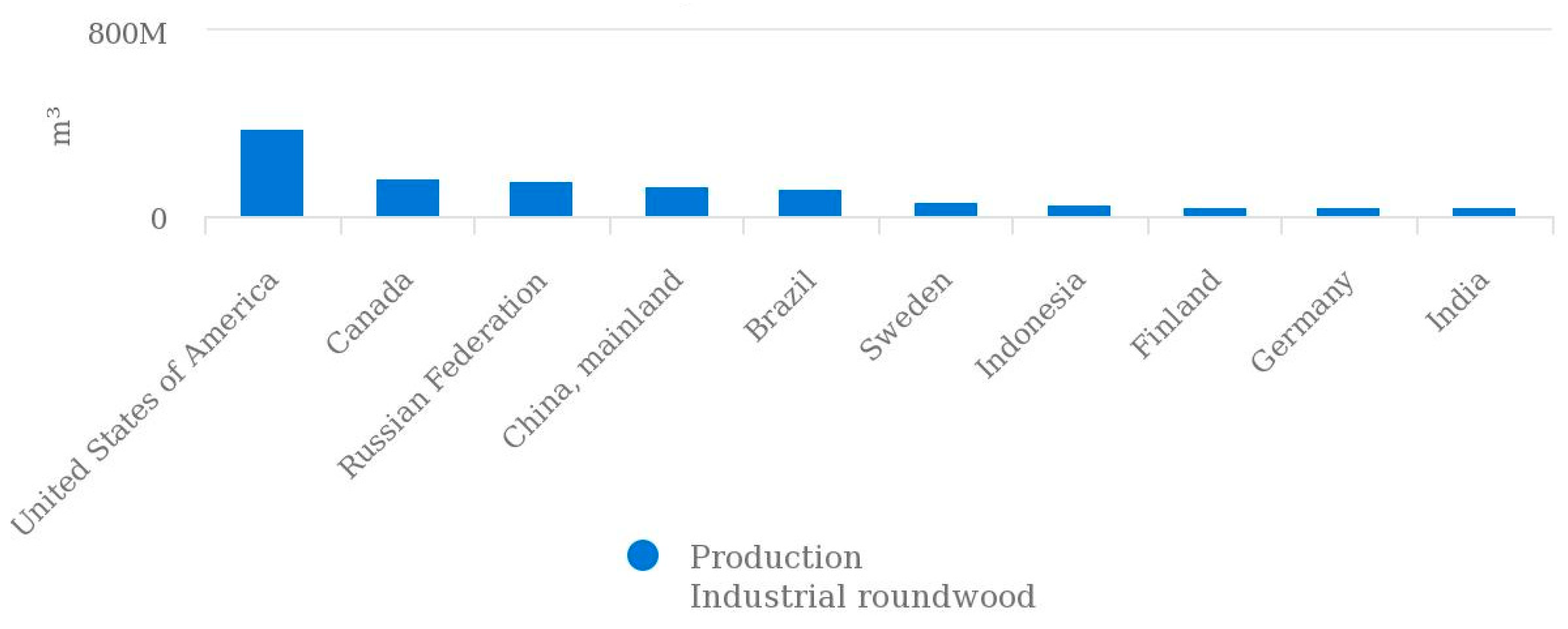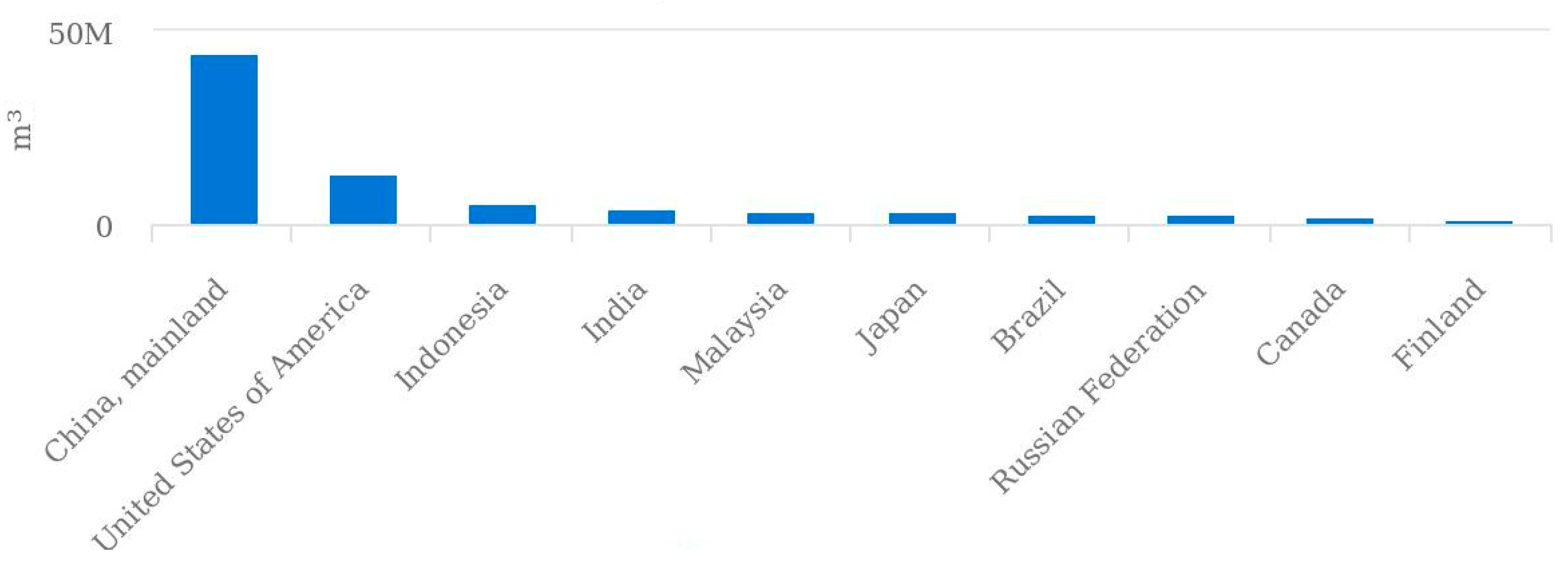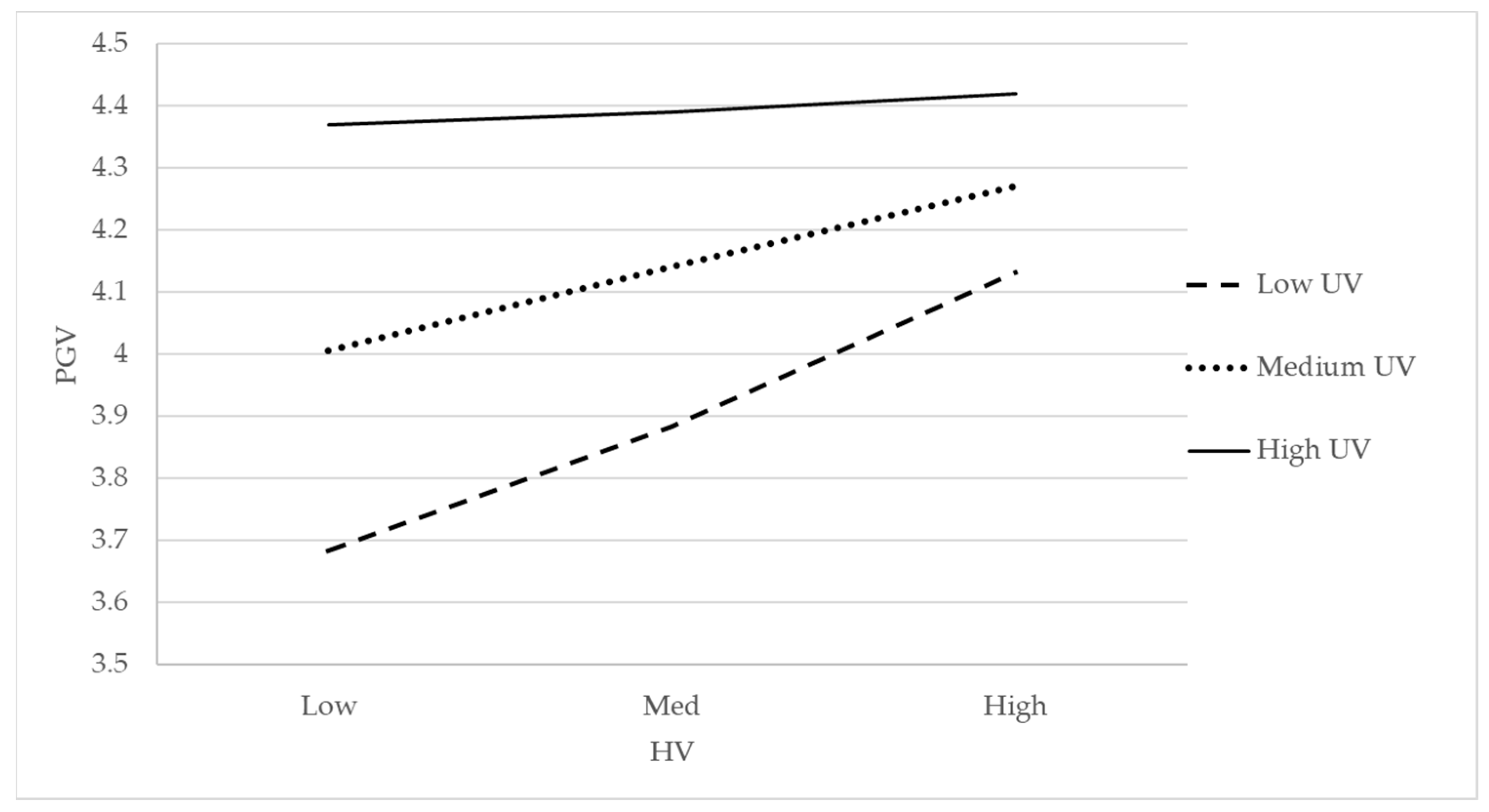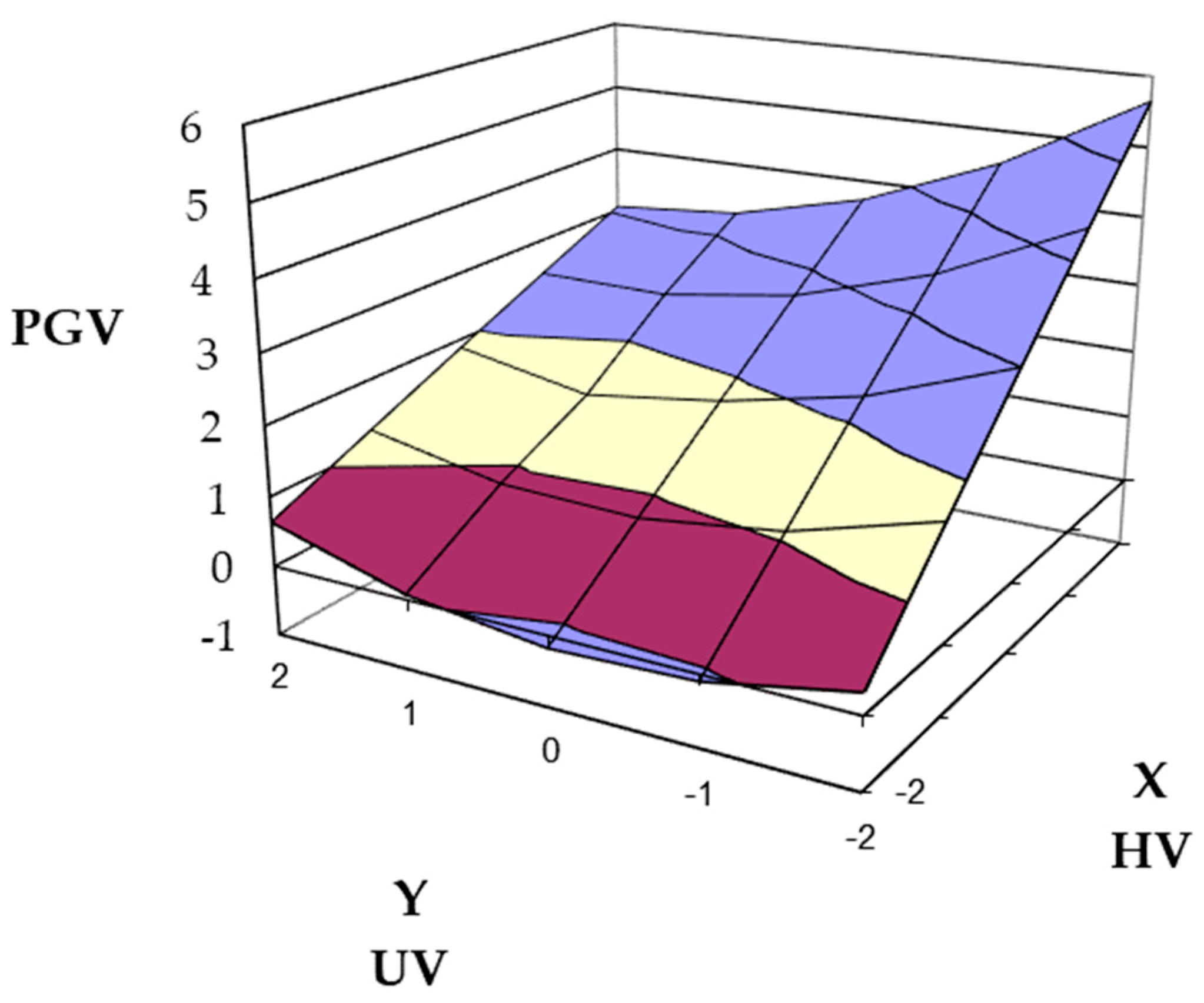Who Prefers Legal Wood: Consumers with Utilitarian or Hedonic Shopping Values?
Abstract
1. Introduction
2. Research Context: Forests in Indonesia
3. Theoretical Background and Hypothesis Development
3.1. Psychological Aspects of Consumers
3.2. Utilitarian Values and Perception of Green Values
3.3. Hedonic and Perception of Green Values
3.4. Interaction between Utilitarian and Hedonic Values
4. Materials and Methods
4.1. Samples and Procedures
4.2. Measures and Analysis
5. Results
6. Discussion and Conclusions
Future Directions and Study Limitations
Author Contributions
Funding
Data Availability Statement
Conflicts of Interest
Appendix A
| Utilitarian Values | Hedonic Values | Perception of Green Values toward Legal Wood |
|---|---|---|
| I accomplish just what I want to on a shopping trip | Going shopping is truly a joy | The environmental functions of legal wood provide very good value for me |
| I am disappointed because I have to go to another store(s) to complete my shopping | I continue to shop, not because I have to, but because I want to | The environmental performance of legal wood meets my expectations |
| A good store visit to me is one that is quick | Compared to other things I could have done, the time spent shopping is truly enjoyable | I use legal wood because it has more environmental concern (than other products) |
| While shopping, I find just the item(s) I am looking for | I enjoy a shopping trip for its own sake, not just for the items I may have purchased | I use legal wood because it is environmentally friendly |
| I feel smart about my shopping decisions | I have a good time during a shopping trip because I am able to act on the “spur of the moment” | I use legal wood because this product has positive benefits for the environment. |
| I can buy what I really need | While shopping, I am able to forget my problems | |
| During a shopping trip, I feel the excitement of the hunt | ||
| Going shopping is not a very nice time out (reversed) | ||
| Going shopping truly feels like an escape | ||
| While shopping, I feel a sense of adventure | ||
| I enjoy being immersed in exciting new products |
References
- FAO. The State of the World’s Forests 2020. Available online: http://www.fao.org/state-of-forests/en/ (accessed on 23 June 2020).
- WWF. Forest Habitat|Habitats|WWF. Available online: https://www.worldwildlife.org/habitats/forest-habitat (accessed on 21 December 2021).
- Tsujino, R.; Yumoto, T.; Kitamura, S.; Djamaluddin, I.; Darnaedi, D. History of forest loss and degradation in Indonesia. Land Use Policy 2016, 57, 335–347. [Google Scholar] [CrossRef]
- Pirard, R.; Irland, L.C. Missing links between timber scarcity and industrial overcapacity: Lessons from the Indonesian Pulp and Paper expansion. For. Policy Econ. 2007, 9, 1056–1070. [Google Scholar] [CrossRef]
- Kato, G. Forestry sector reform and distributional change of natural resource rent in Indonesia. Dev. Econ. 2005, 43, 149–170. [Google Scholar] [CrossRef]
- Obidzinski, K.; Chaudhury, M. Transition to timber plantation based forestry in Indonesia: Towards a feasible new policy. Int. For. Rev. 2009, 11, 79–87. [Google Scholar] [CrossRef]
- FAO. FAOSTAT. Available online: https://www.fao.org/faostat/en/#data/FO/visualize (accessed on 25 October 2023).
- Newsom, D.; Hewitt, D. The Global Impacts of SmartWood Certification; Rainforest Alliance: New York, NY, USA, 2005. [Google Scholar]
- Cashore, B.; Gale, F.; Meidinger, E.; Newsom, D. Confronting Sustainability: Forest Certification in Developing and Transitioning Countries; Yale School of Forestry & Environmental Studies Publication Series: New Haven, CT, USA, 2006. [Google Scholar]
- MoEF. The State of Indonesia’s Forests 2022 towards FOLU Net Sink 2030; Ministry of Environment and Forestry: Jakarta, Indonesia, 2022. [Google Scholar]
- Yuan, Y.; Eastin, I. Forest Certification and Its Influence on the Forest Products Industry in China; CINTRAFOR: Seattle, WA, USA, 2007. [Google Scholar]
- Wibowo, A.; Giessen, L. From voluntary private to mandatory state governance in Indonesian forest certification: Reclaiming authority by bureaucracies. For. Soc. 2018, 2, 28–46. [Google Scholar] [CrossRef]
- George, A.K.; Kizha, A.R.; Daigneault, A. Is forest certification working on the ground? Forest managers perspectives from the northeast U.S. Trees For. People 2022, 7, 100197. [Google Scholar] [CrossRef]
- Santoso, H.; Hadi, S.; Purwanto, P. Understanding and Efforts of Furniture Industries Facing Eco-Labeling in Central Java and Yogyakarta-Indonesia. Int. J. Technol. 2016, 7, 810. [Google Scholar] [CrossRef][Green Version]
- Purnomo, H.; Achdiawan, R.; Parlinah, N.; Irawati, R.H. Value Chain Analysis of Furniture: Action Research to Improve Power Balance and Enhance Livelihoods of Small-Scale Producers. In Proceedings of the XIII World Forestry Congress, Buenos Aires, Argentina, 22 October 2009. [Google Scholar]
- Larasatie, P. Indonesian Furniture Producers: Change Makers or Change Takers? Bioprod. Bus. 2018, 3, 39–50. [Google Scholar] [CrossRef]
- Hock, T. The role of eco-labels in international trade: Can timber certification be implemented as a means to slowing deforestation. Colo. J. Int. Environ. Law Policy 2001, 12, 347. [Google Scholar]
- Anderson, R.C.; Hansen, E.N. The impact of environmental certification on preferences for wood furniture: A conjoint analysis approach. For. Prod. J. 2004, 54, 42. [Google Scholar]
- Bartley, T. Transnational private regulation in practice: The limits of forest and labor standards certification in Indonesia. Bus. Policy 2010, 12, 1–34. [Google Scholar] [CrossRef]
- Schwartz, S.H.; Bilsky, W. Toward a universal psychological structure of human values. J. Pers. Soc. Psychol. 1987, 53, 550. [Google Scholar] [CrossRef]
- Stern, P.C.; Dietz, T.; Abel, T.; Guagnano, G.A.; Kalof, L. A value-belief-norm theory of support for social movements: The case of environmentalism. Hum. Ecol. Rev. 1999, 6, 81–97. [Google Scholar]
- Ajzen, I. The theory of planned behavior. Organ. Behav. Hum. Decis. Process. 1991, 50, 179–211. [Google Scholar] [CrossRef]
- Cheng, Z.-H.; Chang, C.-T.; Lee, Y.-K. Linking hedonic and utilitarian shopping values to consumer skepticism and green consumption: The roles of environmental involvement and locus of control. Rev. Manag. Sci. 2020, 14, 61–85. [Google Scholar] [CrossRef]
- Nugroho, H.Y.S.H.; Indrajaya, Y.; Astana, S.; Murniati; Suharti, S.; Basuki, T.M.; Yuwati, T.W.; Putra, P.B.; Narendra, B.H.; Abdulah, L.; et al. A Chronicle of Indonesia’s Forest Management: A Long Step towards Environmental Sustainability and Community Welfare. Land 2023, 12, 1238. [Google Scholar] [CrossRef]
- Lin, S.-T.; Niu, H.-J. Green consumption: Environmental knowledge, environmental consciousness, social norms, and purchasing behavior. Bus. Strategy Environ. 2018, 27, 1679–1688. [Google Scholar] [CrossRef]
- Kuhl, J. A functional-design approach to motivation and self-regulation: The dynamics of personality systems interactions. In Handbook of Self-Regulation; Elsevier: Amsterdam, The Netherlands, 2000; pp. 111–169. [Google Scholar]
- Snyder, M. Traits and motives in the psychology of personality. Psychol. Inq. 1994, 5, 162–166. [Google Scholar] [CrossRef]
- McClelland, D.C. How motives, skills, and values determine what people do. Am. Psychol. 1985, 40, 812. [Google Scholar] [CrossRef]
- Khachatryan, H.; Rihn, A.; Behe, B.; Hall, C.; Campbell, B.; Dennis, J.; Yue, C. Visual attention, buying impulsiveness, and consumer behavior. Mark. Lett. 2018, 29, 23–35. [Google Scholar] [CrossRef]
- Youn, S.; Faber, R.J. Impulse buying: Its relation to personality traits and cues. ACR N. Am. Adv. 2000, 27, 179–185. [Google Scholar]
- Vlosky, R.P.; Ozanne, L.K.; Fontenot, R.J. A conceptual model of US consumer willingness-to-pay for environmentally certified wood products. J. Consum. Mark. 1999, 16, 122–140. [Google Scholar] [CrossRef]
- Deci, E.L.; Ryan, R.M. The “what” and “why” of goal pursuits: Human needs and the self-determination of behavior. Psychol. Inq. 2000, 11, 227–268. [Google Scholar] [CrossRef]
- Schultheiss, O.; Brunstein, J. (Eds.) Implicit Motives; Oxford University Press: Oxford, UK, 2010. [Google Scholar]
- Halisch, F.; Kuhl, J. Motivation, Intention, and Volition; Springer Science & Business Media: Berlin, Germany, 2012. [Google Scholar]
- Laurin, K.; Fitzsimons, G.M.; Kay, A.C. Social disadvantage and the self-regulatory function of justice beliefs. J. Pers. Soc. Psychol. 2011, 100, 149. [Google Scholar] [CrossRef]
- Homburg, C.; Jozić, D.; Kuehnl, C. Customer experience management: Toward implementing an evolving marketing concept. J. Acad. Mark. Sci. 2017, 45, 377–401. [Google Scholar] [CrossRef]
- Barbarossa, C.; De Pelsmacker, P.; Moons, I. Personal values, green self-identity and electric car adoption. Ecol. Econ. 2017, 140, 190–200. [Google Scholar] [CrossRef]
- Wieczorek, A.J. Sustainability transitions in developing countries: Major insights and their implications for research and policy. Environ. Sci. Policy 2018, 84, 204–216. [Google Scholar] [CrossRef]
- Buerke, A.; Straatmann, T.; Lin-Hi, N.; Müller, K. Consumer awareness and sustainability-focused value orientation as motivating factors of responsible consumer behavior. Rev. Manag. Sci. 2017, 11, 959–991. [Google Scholar] [CrossRef]
- van Dam, Y.K.; Fischer, A.R. Buying green without being seen. Environ. Behav. 2015, 47, 328–356. [Google Scholar] [CrossRef]
- Babin, B.J.; Darden, W.R.; Griffin, M. Work and/or fun: Measuring hedonic and utilitarian shopping value. J. Consum. Res. 1994, 20, 644–656. [Google Scholar] [CrossRef]
- Scarpi, D. Work and fun on the internet: The effects of utilitarianism and hedonism online. J. Interact. Mark. 2012, 26, 53–67. [Google Scholar] [CrossRef]
- Peattie, K. Green consumption: Behavior and norms. Annu. Rev. Environ. Resour. 2010, 35, 195–228. [Google Scholar] [CrossRef]
- Cropanzano, R.; Anthony, E.L.; Daniels, S.R.; Hall, A.V. Social exchange theory: A critical review with theoretical remedies. Acad. Manag. Ann. 2017, 11, 479–516. [Google Scholar] [CrossRef]
- Bolton, R.N.; Drew, J.H. A multistage model of customers’ assessments of service quality and value. J. Consum. Res. 1991, 17, 375–384. [Google Scholar] [CrossRef]
- Patterson, P.G.; Spreng, R.A. Modelling the relationship between perceived value, satisfaction and repurchase intentions in a business-to-business, services context: An empirical examination. Int. J. Serv. Ind. Manag. 1997, 8, 414–434. [Google Scholar] [CrossRef]
- Jones, M.A.; Reynolds, K.E.; Arnold, M.J. Hedonic and utilitarian shopping value: Investigating differential effects on retail outcomes. J. Bus. Res. 2006, 59, 974–981. [Google Scholar] [CrossRef]
- Dhar, R.; Wertenbroch, K. Consumer choice between hedonic and utilitarian goods. J. Mark. Res. 2000, 37, 60–71. [Google Scholar] [CrossRef]
- Picot-Coupey, K.; Krey, N.; Huré, E.; Ackermann, C.-L. Still work and/or fun? Corroboration of the hedonic and utilitarian shopping value scale. J. Bus. Res. 2021, 126, 578–590. [Google Scholar] [CrossRef]
- Lim, E.A.C.; Ang, S.H. Hedonic vs. utilitarian consumption: A cross-cultural perspective based on cultural conditioning. J. Bus. Res. 2008, 61, 225–232. [Google Scholar] [CrossRef]
- Chen, Y.-S. The driver of green innovation and green image–green core competence. J. Bus. Ethics 2008, 81, 531–543. [Google Scholar] [CrossRef]
- Testa, F.; Pretner, G.; Iovino, R.; Bianchi, G.; Tessitore, S.; Iraldo, F. Drivers to green consumption: A systematic review. Environ. Dev. Sustain. 2021, 23, 4826–4880. [Google Scholar] [CrossRef]
- To, P.-L.; Liao, C.; Lin, T.-H. Shopping motivations on Internet: A study based on utilitarian and hedonic value. Technovation 2007, 27, 774–787. [Google Scholar] [CrossRef]
- Monroe, K.B. Buyers’ subjective perceptions of price. J. Mark. Res. 1973, 10, 70–80. [Google Scholar]
- Boyle, P.J.; Lathrop, E.S. Are consumers’ perceptions of price–quality relationships well calibrated? Int. J. Consum. Stud. 2009, 33, 58–63. [Google Scholar] [CrossRef]
- Ghali-Zinoubi, Z.; Toukabri, M. The antecedents of the consumer purchase intention: Sensitivity to price and involvement in organic product: Moderating role of product regional identity. Trends Food Sci. Technol. 2019, 90, 175–179. [Google Scholar] [CrossRef]
- Kollmuss, A.; Agyeman, J. Mind the gap: Why do people act environmentally and what are the barriers to pro-environmental behavior? Environ. Educ. Res. 2002, 8, 239–260. [Google Scholar] [CrossRef]
- Scarpi, D. Fashion stores between fun and usefulness. J. Fash. Mark. Manag. Int. J. 2006, 10, 7–24. [Google Scholar] [CrossRef]
- Trope, Y.; Liberman, N. Construal-level theory of psychological distance. Psychol. Rev. 2010, 117, 440. [Google Scholar] [CrossRef]
- Trope, Y.; Liberman, N.; Wakslak, C. Construal levels and psychological distance: Effects on representation, prediction, evaluation, and behavior. J. Consum. Psychol. 2007, 17, 83–95. [Google Scholar] [CrossRef]
- Tangari, A.H.; Burton, S.; Smith, R.J. Now that’s a bright idea: The influence of consumer elaboration and distance perceptions on sustainable choices. J. Retail. 2015, 91, 410–421. [Google Scholar] [CrossRef]
- Stern, P.C. New environmental theories: Toward a coherent theory of environmentally significant behavior. J. Soc. Issues 2000, 56, 407–424. [Google Scholar] [CrossRef]
- Fenton-O’Creevy, M.; Dibb, S.; Furnham, A. Antecedents and consequences of chronic impulsive buying: Can impulsive buying be understood as dysfunctional self-regulation? Psychol. Mark. 2018, 35, 175–188. [Google Scholar] [CrossRef]
- Darrat, A.A.; Darrat, M.A.; Amyx, D. How impulse buying influences compulsive buying: The central role of consumer anxiety and escapism. J. Retail. Consum. Serv. 2016, 31, 103–108. [Google Scholar] [CrossRef]
- Sherry, J.F., Jr. A sociocultural analysis of a Midwestern American flea market. J. Consum. Res. 1990, 17, 13–30. [Google Scholar] [CrossRef]
- Lee, K. The green purchase behavior of Hong Kong young consumers: The role of peer influence, local environmental involvement, and concrete environmental knowledge. J. Int. Consum. Mark. 2010, 23, 21–44. [Google Scholar] [CrossRef]
- Samuelson, C.D. Energy conservation: A social dilemma approach. Soc. Behav. 1990, 5, 207–230. [Google Scholar]
- Griskevicius, V.; Cantú, S.M.; Van Vugt, M. The evolutionary bases for sustainable behavior: Implications for marketing, policy, and social entrepreneurship. J. Public Policy Mark. 2012, 31, 115–128. [Google Scholar] [CrossRef]
- Lindenberg, S.; Steg, L. Normative, gain and hedonic goal frames guiding environmental behavior. J. Soc. Issues 2007, 63, 117–137. [Google Scholar] [CrossRef]
- Pelletier, L.G.; Tuson, K.M.; Green-Demers, I.; Noels, K.; Beaton, A.M. Why are you doing things for the environment? The motivation toward the environment scale (mtes) 1. J. Appl. Soc. Psychol. 1998, 28, 437–468. [Google Scholar] [CrossRef]
- De Young, R. New ways to promote proenvironmental behavior: Expanding and evaluating motives for environmentally responsible behavior. J. Soc. Issues 2000, 56, 509–526. [Google Scholar] [CrossRef]
- Kehr, H.M. Implicit/explicit motive discrepancies and volitional depletion among managers. Pers. Soc. Psychol. Bull. 2004, 30, 315–327. [Google Scholar] [CrossRef] [PubMed]
- Kazén, M.; Kuhl, J. Directional discrepancy between implicit and explicit power motives is related to well-being among managers. Motiv. Emot. 2011, 35, 317–327. [Google Scholar] [CrossRef]
- Podsakoff, P.M.; MacKenzie, S.B.; Podsakoff, N.P. Sources of method bias in social science research and recommendations on how to control it. Annu. Rev. Psychol. 2012, 63, 539–569. [Google Scholar] [CrossRef] [PubMed]
- Chen, Y.-S. Towards green loyalty: Driving from green perceived value, green satisfaction, and green trust. Sustain. Dev. 2013, 21, 294–308. [Google Scholar] [CrossRef]
- Wang, P.; Liu, Q.; Qi, Y. Factors influencing sustainable consumption behaviors: A survey of the rural residents in China. J. Clean. Prod. 2014, 63, 152–165. [Google Scholar] [CrossRef]
- Zelezny, L.C.; Chua, P.-P.; Aldrich, C. New ways of thinking about environmentalism: Elaborating on gender differences in environmentalism. J. Soc. Issues 2000, 56, 443–457. [Google Scholar] [CrossRef]
- Shanock, L.R.; Baran, B.E.; Gentry, W.A.; Pattison, S.C.; Heggestad, E.D. Polynomial regression with response surface analysis: A powerful approach for examining moderation and overcoming limitations of difference scores. J. Bus. Psychol. 2010, 25, 543–554. [Google Scholar] [CrossRef]
- Edwards, J.R. Alternatives to difference scores: Polynomial regression and response surface methodology. In Measuring and Analyzing Behavior in Organizations: Advances in Measurement and Data Analysis; Drasgow, F., Schmitt, N., Eds.; Wiley: Hoboken, NJ, USA, 2002; pp. 350–400. [Google Scholar]
- Harris, M.M.; Anseel, F.; Lievens, F. Keeping up with the Joneses: A field study of the relationships among upward, lateral, and downward comparisons and pay level satisfaction. J. Appl. Psychol. 2008, 93, 665. [Google Scholar] [CrossRef]
- Steg, L.; Perlaviciute, G.; Van Der Werff, E.; Lurvink, J. The Significance of Hedonic Values for Environmentally Relevant Attitudes, Preferences, and Actions. Environ. Behav. 2014, 46, 163–192. [Google Scholar] [CrossRef]
- Beatty, S.E.; Ferrell, M.E. Impulse buying: Modeling its precursors. J. Retail. 1998, 74, 169–191. [Google Scholar] [CrossRef]
- Chandon, P.; Wansink, B.; Laurent, G. A benefit congruency framework of sales promotion effectiveness. J. Mark. 2000, 64, 65–81. [Google Scholar] [CrossRef]
- Wakefield, K.L.; Baker, J. Excitement at the mall: Determinants and effects on shopping response. J. Retail. 1998, 74, 515–539. [Google Scholar] [CrossRef]
- van Trijp, H.C.; Hoyer, W.D.; Inman, J.J. Why switch? product category–level explanations for true variety-seeking behavior. J. Mark. Res. 1996, 33, 281–292. [Google Scholar]
- Hetsroni, A. The relationship between values and appeals in Israeli advertising: A smallest space analysis. J. Advert. 2000, 29, 55–68. [Google Scholar] [CrossRef]
- Larasatie, P.; Setiowati, S. From Fingerprint to Footprint: Using Point of Interest (POI) Recommendation System in Marketing Applications. Asian J. Technol. Manag. 2019, 12, 118–131. [Google Scholar] [CrossRef]
- Hartmann, P.; Apaolaza Ibáñez, V.; Forcada Sainz, F.J. Green branding effects on attitude: Functional versus emotional positioning strategies. Mark. Intell. Plan. 2005, 23, 9–29. [Google Scholar] [CrossRef]
- Prakash, A. Green marketing, public policy and managerial strategies. Bus. Strategy Environ. 2002, 11, 285–297. [Google Scholar] [CrossRef]
- IKEA. Our View on Supply Chain Due Diligence—IKEA Global. Available online: https://www.ikea.com/global/en/our-business/our-view-on/supply-chain-due-diligence/ (accessed on 7 September 2023).
- Larasatie, P.; Guerrero, J.E.; Conroy, K.; Hall, T.E.; Hansen, E.; Needham, M.D. What Does the Public Believe about Tall Wood Buildings? An Exploratory Study in the US Pacific Northwest. J. For. 2018, 116, 429–436. [Google Scholar] [CrossRef]
- Costa, P.T.; McCrae, R.R. A five-factor theory of personality. Five-Factor Model Personal. Theor. Perspect. 1999, 2, 51–87. [Google Scholar]






| Frequency | Percentage | ||
|---|---|---|---|
| Age | <31 | 110 | 21.4 |
| 31–40 | 146 | 28.4 | |
| 41–50 | 169 | 32.8 | |
| 51–60 | 86 | 16.7 | |
| >60 | 4 | 0.7 | |
| Education | Low and Middle | 77 | 14.9 |
| Higher | 438 | 85.1 | |
| Gender | Men | 280 | 54.3 |
| Women | 235 | 45.7 |
| Mean | SD | 1 | 2 | 3 | 4 | 5 | 6 | ||
|---|---|---|---|---|---|---|---|---|---|
| 1 | Education | 1.8 | 0.35 | 1 | |||||
| 2 | Gender | 1.46 | 0.99 | −0.002 | 1 | ||||
| 3 | Age | 40.14 | 10.13 | 0.317 ** | −0.108 ** | 1 | |||
| 4 | PGV | 4.17 | 0.67 | 0.031 | −0.132 ** | 0.093 ** | 1 | ||
| 5 | UV | 3.90 | 0.66 | −0.055 | −0.224 ** | 0.055 | −0.258 ** | 1 | |
| 6 | HV | 3.08 | 0.65 | −0.081 ** | 0.104 ** | −0.183 ** | 0.105 ** | 0.304 ** | 1 |
| Variables | Model 1 | Model 2 | Model 3 | Model 4 | ||||||||
|---|---|---|---|---|---|---|---|---|---|---|---|---|
| B | SE | VIF | B | SE | VIF | B | SE | VIF | B | SE | VIF | |
| Control Variables | ||||||||||||
| Education | −0.001 | 0.020 | 1.140 | 0.010 | 0.019 | 1.145 | 0.006 | 0.019 | 1.148 | 0.042 | 0.074 | 1.157 |
| Gender | −0.152 ** | 0.055 | 1.019 | −0.085 | 0.052 | 1.070 | −0.076 | 0.051 | 1.071 | −0.069 | 0.051 | 1.124 |
| Age | 0.005 * | 0.003 | 1.151 | 0.006 ** | 0.003 | 1.181 | 0.006 ** | 0.003 | 1.181 | 0.006 ** | 0.003 | 1.070 |
| Constant | 4.205 | 0.183 | 2.089 | 0.305 | −1.188 | 0.773 | 1.789 | 1.269 | ||||
| Main Variables | ||||||||||||
| UV | 0.319 ** | 0.041 | 1.124 | 1.131 ** | 0.181 | 23.35 | −0.282 | 0.435 | 137.1 | |||
| HV | 0.208 ** | 0.041 | 1.107 | 1.204 ** | 0.221 | 33.73 | 0.97 ** | 0.394 | 110.1 | |||
| HV and UV Interaction | −0.248 ** | 0.054 | 41.98 | −0.183 ** | 0.058 | 51.4 | ||||||
| UV2 | 0.161 ** | 0.045 | 83.0 | |||||||||
| HV2 | −0.006 | 0.034 | 49.4 | |||||||||
| Model Fit | ||||||||||||
| .sig | 0.008 | 0.000 | 0.000 | 0.000 | ||||||||
| F | 4.143 | 17.453 | 18.615 | 15.885 | ||||||||
| R Square | 0.024 | 0.146 | 0.180 | 0.200 | ||||||||
| Adj R Square | 0.018 | 0.138 | 0.171 | 0.188 | ||||||||
| ΔR2 Model 1 to 2 | ||||||||||||
| ΔR2 Model 2 to 3 | 0.104 | |||||||||||
| ΔR2 Model 3 to 4 | 0.034 | |||||||||||
| ΔR2 Model 4 to 5 | 0.020 | |||||||||||
| Testing Slopes and Curves | ||||
|---|---|---|---|---|
| Standard | Test | |||
| Effect | Coefficient | Error | Stat (t) | p-Value |
| a1: Slope along x = y (as related to Z) | 0.69 | 0.70 | 0.982 | 0.326 |
| a2: Curvature on x = y (as related to Z) | −0.03 | 0.11 | −0.264 | 0.792 |
| a3: Slope along x = −y (as related to Z) | 1.25 | 0.45 | 2.810 | 0.005 |
| a4: Curvature on x = −y (as related to Z) | 0.34 | 0.09 | 3.973 | 0.000 |
Disclaimer/Publisher’s Note: The statements, opinions and data contained in all publications are solely those of the individual author(s) and contributor(s) and not of MDPI and/or the editor(s). MDPI and/or the editor(s) disclaim responsibility for any injury to people or property resulting from any ideas, methods, instructions or products referred to in the content. |
© 2023 by the authors. Licensee MDPI, Basel, Switzerland. This article is an open access article distributed under the terms and conditions of the Creative Commons Attribution (CC BY) license (https://creativecommons.org/licenses/by/4.0/).
Share and Cite
Larasatie, P.; Handrito, R.P.; Fitriastuti, T.; Sari, D.M. Who Prefers Legal Wood: Consumers with Utilitarian or Hedonic Shopping Values? Forests 2023, 14, 2163. https://doi.org/10.3390/f14112163
Larasatie P, Handrito RP, Fitriastuti T, Sari DM. Who Prefers Legal Wood: Consumers with Utilitarian or Hedonic Shopping Values? Forests. 2023; 14(11):2163. https://doi.org/10.3390/f14112163
Chicago/Turabian StyleLarasatie, Pipiet, Radityo Putro Handrito, Triana Fitriastuti, and Dhina Mustika Sari. 2023. "Who Prefers Legal Wood: Consumers with Utilitarian or Hedonic Shopping Values?" Forests 14, no. 11: 2163. https://doi.org/10.3390/f14112163
APA StyleLarasatie, P., Handrito, R. P., Fitriastuti, T., & Sari, D. M. (2023). Who Prefers Legal Wood: Consumers with Utilitarian or Hedonic Shopping Values? Forests, 14(11), 2163. https://doi.org/10.3390/f14112163






